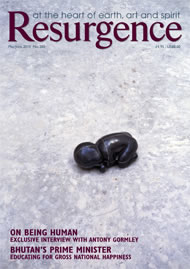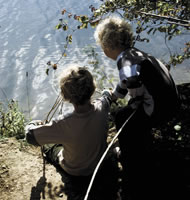For children, Nature comes in many forms. A newborn calf, a pet that lives and dies, a fort nestling in stinging nettles, a worn path through the woods. Whatever shape it takes, Nature offers a child a larger world, separate from his or her parents, and, unlike television, it does not steal time but amplifies it.
Many of us grew into adulthood taking Nature’s gifts for granted; we assumed (when we thought of it at all) that generations to come would receive these same gifts. But something has changed. Now we see the emergence of what I have come to call Nature Deficit Disorder.
This term is by no means a medical diagnosis but it does offer a way to think about the problem and the possibilities – for children and for the rest of us as well.
I first became aware of this transformation in the late 1980s when, in the course of researching a book, I interviewed thousands of children and their parents. I often think of the wonderfully honest comment made by Paul, a San Diego schoolboy who told me: “I like to play indoors ’cause that’s where all the electrical outlets are.”
In many classrooms, I heard variations on that statement. True, for many children, Nature still offers wonders. But for many, playing in Nature seemed so…Unproductive. Off-limits. Alien.
One schoolgirl I spoke to told me she wanted to be a poet when she grew up.
“When I’m in the woods,” she said, “I feel like I’m in my mother’s shoes.”
She was one of those exceptional children who do still spend time outside, in solitude. In her case, Nature represented beauty – and refuge – and she told me of a part of the woods she had thought of as being her special place.
“There was a big waterfall and a creek on one side of it. I’d dug a big hole there, and sometimes I’d take a tent back there, or a blanket, and just lie down in the hole and look up at the trees and sky. Sometimes, I’d fall asleep back there. I just felt free; it was like my place and I could do what I wanted, with nobody to stop me. I used to go down there almost every day.”
The young poet’s face then flushed. Her voice thickened.
“And then they just cut the woods down. It was like they cut down part of me.”
Over time, I came to understand how Nature serves as a blank slate upon which a child draws and reinterprets a culture’s fantasies. Nature inspires creativity in a child by demanding visualisation and full use of the senses. Given a chance, a child will bring the confusion of the world into the woods, wash it in the creek, and turn it over to see what lies on the unseen side of that confusion.
Nature can frighten a child, too, and this fright serves a purpose. In Nature, a child finds freedom, fantasy and privacy; a place distant from the adult world and, as our young poet discovered, a separate peace.
These are some of the utilitarian values of Nature, but at a deeper level Nature gives itself to children – for its own sake, not as a reflection of culture. At this level, inexplicable Nature provokes humility.
As the pre-eminent Nature poet Gary Snyder writes, we attach two meanings to the word ‘nature’, which comes from the Latin natura – birth, constitution, character, course of things – and, beyond natura, nasci – to be born.
When considering children in Nature, one hungers for a richer description, a definition with more breathing room – one that does not either include everything as natural or restrict Nature to virgin forest.
Gary Snyder is drawn to poet John Milton’s phrase “a wilderness of sweets”. “Milton’s usage of wilderness catches the very real condition of energy and richness that is so often found in wild systems. A ‘wilderness of sweets’ is like billions of herring or mackerel babies in the ocean, wild prairie grass seed … all the incredible fecundity of small animals and plants, feeding the web,” he explains. “But from another side, wilderness has implied chaos, eros, the unknown, realms of taboo, the habitat of both the ecstatic and the demonic. In both senses, it is a place of archetypal power, teaching and challenge.”
When we think of children and Nature, this third, more bountiful understanding is helpful. When I use the term ‘Nature’ in a general way, I mean natural wildness: biodiversity, abundance – related loose parts in a backyard or a rugged mountain ridge. Most of all, Nature is reflected in our capacity for wonder. Nasci. To be born.
As I was conducting my interviews, one mother summed up the mantra I was to hear over and over again from parents, grandparents, teachers and other adults across the country: “It’s all this watching,” she said.
“We’ve become a more sedentary society. When I was a kid growing up in Detroit, we were always outdoors. The kids who stayed indoors were the odd ones. We didn’t have any huge wide-open spaces but we were always outdoors on the streets – in the vacant lots, jumping rope or playing baseball or hopscotch. We were out there playing, even after we got older.”
Another parent nodded in agreement, adding: “Something else was different too, when we were young: our parents were outdoors as well. I’m not saying they were joining health clubs and things like that but they were out of the house, out on the porch, talking to neighbours. As far as physical fitness goes, today’s kids are the sorriest generation in the history of the United States. Their parents may be jogging but the kids just aren’t outside.”
Over time, I came to understand better some of the complexity represented by the boy who preferred electrical outlets and the poet who had lost her special spot in the woods. I also learned this: parents, educators, other adults, institutions – our culture itself – may say one thing to children about Nature’s gifts, but so many of our actions and messages, especially the ones we cannot hear ourselves deliver, are different.
And children hear very well.








